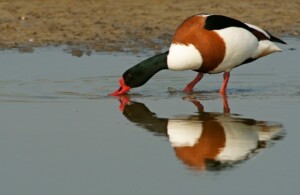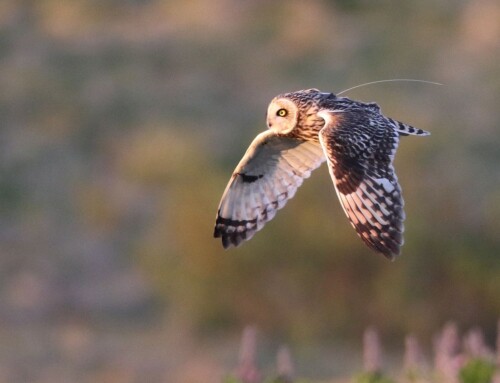LINKED PAPER  Ringing, tracking and counting data reveal five wintering patterns in European Common Shelducks. Cimiotti, D.S., Cimiotti, D.V., Hötker, H., Garthe, S. 2023. IBIS. DOI: 10.1111/ibi.13278. VIEW
Ringing, tracking and counting data reveal five wintering patterns in European Common Shelducks. Cimiotti, D.S., Cimiotti, D.V., Hötker, H., Garthe, S. 2023. IBIS. DOI: 10.1111/ibi.13278. VIEW
After the breeding season, Common Shelducks (Tadorna tadorna) in Europe embark on a long journey and migrate to a moulting area, where they become flightless until they have grown new feathers. The catchment area of these moulting areas have been the focus of several ringing studies before (Oelke & Wietfeld 1979; Kempf 1993; Koffijberg et al. 2015; Walmsley 1981; Green et al. 2021), but the wintering patterns that follow this moult migration have remained unclear. However, this information is an important basis for conservation efforts.
Why is this important?
For example, the condition of the habitat in one of the used areas can influence the body condition of the individuals using it and thus fitness (Ebbinge 1989; Hötker 2002). Considering that we live in a time when environmental conditions change rapidly, it is good to know the constraints of wintering patterns and to understand how populations are connected to predict how individuals may adapt (Piersma & Lindström 2004).

Figure 1. Theoretical scheme of possible winter migration patterns (dashed lines) that were studied.
What did we do?
Me and my colleagues aimed to identify the main wintering areas of the European Shelducks, to find out if winter temperature is an important factor in winter dispersal, to investigate how breeding and wintering areas are geographically linked, and to investigate the possible effects of moult migration on the patterns of connectivity between the breeding and wintering areas. For this purpose, we used several data sources that contained the wintering locations of individual Shelducks. Besides our own tracking data from a breeding population in Germany, we also evaluated ringing data collected by numerous bird ringers and ring readers in the EURING database. We assigned the data to one of the possible winter migration patterns shown in Figure 2. These were (I) individuals that moved to a distant wintering area after moulting that was not close to the moulting or breeding area; (II) individuals that stayed in the moulting area for the winter; (III) individuals that moved back towards their breeding area after moulting and wintered in one or several nearby areas; (IV) individuals that moved back to the breeding area directly after moulting and wintered there; (V) individuals that used the same area for breeding, moulting and wintering. We additionally studied mid-January count data from the International Waterbird Census (IWC).
What did we find out?
First of all, we found evidence for all the possible wintering patterns shown in Figure 1 to occur in European Shelducks. We found that even several of these patterns were carried out by individuals from individual breeding populations. In other words, the Shelducks showed high migratory diversity. This is probably good news, as high diversity of migration patterns has been shown to reduce the risk of severe population declines due to downgrading habitat conditions or severe environmental perturbation in single wintering areas (Gilroy et al. 2016).

Figure 2. This individual Shelduck male has used a wintering area separate from its breeding and moulting area © Dagmar Cimiotti.
Second, we found that temperature was an important constraint. Shelducks from cold breeding areas with long-term wintering temperatures below 0°C always spent the winter in warmer wintering areas. That was not particularly surprising, as Shelducks filter feed from soft mud, which may not be frozen. However, we also found that some individuals used wintering areas nearby or in a moulting area, even if these were sometimes colder than their own breeding area and even frozen during parts of the winter in some years. This supports the idea that the location of the moulting area influences the geographic location of the wintering area.
Another aspect of our study was that we reviewed all available data sources for wintering Shelducks compared to other seasons, like this were able to draw a more valid picture and highlight areas of knowledge gaps.
References
Ebbinge, B.S. 1989. A multifactorial explanation for variation in breeding performance of Brent Geese Branta bernicla. IBIS 131. VIEW
Gilroy, J.J., Gill, J.A., Butchart, S.H.M., Jones, V.R. & Franco, A.M.A. 2016. Migratory diversity predicts population declines in birds. Ecology Letters 19. VIEW
Green, R.M.W., Burton, N.H.K. & Cook, A.S.C.P. 2021. Migratory movements of British and Irish Common Shelduck Tadorna tadorna: A review of ringing data and a pilot tracking study to inform potential interactions with offshore wind farms in the North Sea. Ringing & Migration 56. VIEW
Hötker, H. 2002. Arrival of pied avocets Recurvirostra avosetta at the breeding site: effects of winter quarters and consequences for reproductive success. Ardea 90. VIEW
Kempf, N. 1993. Ökologie der mausernden Brandgänse. Jahresbericht des Forschungs- und Technologiezentrum Westküste 5. VIEW
Koffijberg, K., Laursen, K., Hälterlein, B., Reichert, G., Frikke, J. & Soldaat, L. 2015. Trends of breeding birds in the Wadden Sea 1991 – 2013: Wadden Sea Ecoystem No. 35. Common Wadden Sea Secretariat, Wilhelmshaven. VIEW
Oelke, H. & Wietfeld, J. 1979. Ergebnisse der Beringung von Brandgänsen (Tadorna tadorna) auf dem Großen Knechtsand (Elbe-Wester-Mündung). Beiträge zur Naturkunde Niedersachsens 32. VIEW
Piersma, T. & Lindström, A. 2004. Migrating shorebirds as integrative sentinels of global environmental change. IBIS 146. VIEW
Walmsley, J.G. 1981. Interpopulations-Bewegungen von Brandgänsen Tadorna tadorna (L.). Beiträge zur Naturkunde Niedersachsens 34. VIEW
Image credit
Top right: Feeding Common Shelduck © Marko König.




